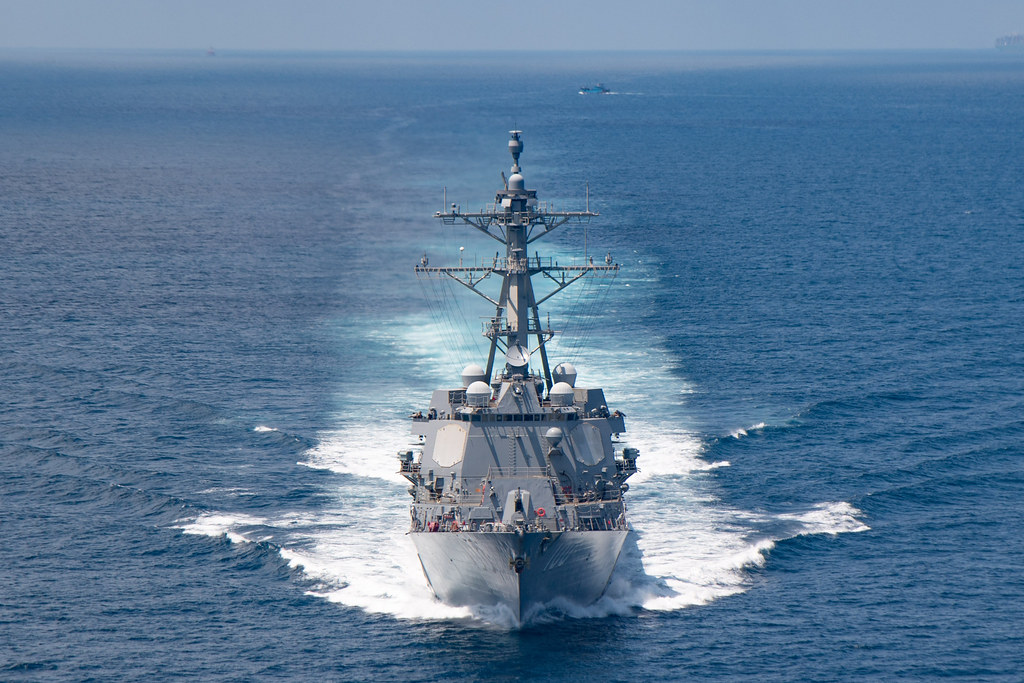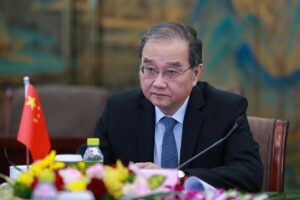Following House Speaker Nancy Pelosi’s visit to Taiwan in early August 2022, China conducted a series of military exercises around Taiwan. China’s military exercises have been understood as a retaliation for Speaker Pelosi’s trip to Taiwan and Taiwan’s present pro-U.S. policies. During the drills, China’s aircraft and ships constantly crossed the median line in the Taiwan Strait, indicating that China was seeking to create a new status quo. Despite Taiwan’s reiteration of the international status of the Taiwan Strait and pressure from the wider international community, China has denied the existence of the median line and claims that the Taiwan Strait is not international waters. Recently, China has also vowed to speed up its military modernization so that the People’s Liberation Army (PLA) can meet near-term targets by its 100th anniversary in 2027. Though an immediate, large-scale military confrontation in the Taiwan Strait remains relatively unlikely, many argue that Taiwan, the U.S., and like-minded parties in the Indo-Pacific region should carefully respond to China’s “gray zone activities.”
In fact, so-called gray zone activities are not a unique concept or tactic developed by China. Rather, gray zone activities were initially introduced and developed by the United States. In the Quadrennial Defense Review (QDR), published in 2010, the U.S. Department of Defense proposed that “the future strategic landscape will increasingly feature challenges in the ambiguous gray area that is neither fully war nor fully peace.”1Note: US Department of Defense (2010), Quadrennial Defense Review Report, <https://dod.defense.gov/Portals/1/features/defenseReviews/QDR/QDR_as_of_29JAN10_1600.pdf>, p. 73. In the 2015 U.S. Special Operation Command White Paper: The Gray Zone, “gray zone challenges” are further defined as “competitive interactions among and within state and non-state actors that fall between the traditional war and peace duality.”2Note: US Special Operation Command (2015), US Special Operation Command White Paper: The Gray Zone, <https://info.publicintelligence.net/USSOCOM-GrayZones.pdf>, p. 1. Noteworthily, similar to the United States, since 2013, Japan has noted “gray zone situations” and indicated potential conflicts that might occur due to territorial sovereignty and interests in the Asia-Pacific region. The concept of gray zone situations is explicitly articulated in Japan’s 2013 National Security Strategyand the Defense of Japan 2014.3Note: Cabinet Secretariat of Japan (2013), “National Security Strategy of Japan,” <https://www.cas.go.jp/jp/siryou/131217anzenhoshou/pamphlet_en.pdf>, p. 22.; see also Japan Ministry of Defense (2014), Defense of Japan 2014, <https://warp.da.ndl.go.jp/info:ndljp/pid/11591426/www.mod.go.jp/e/publ/w_paper/pdf/2014/DOJ2014_Digest_part1_web_1031.pdf> Recently, in its Defense of Japan 2022, Japan has expressed its grave concern about the persistent gray zone situations and the pressing threats posed by China.4Note: Japan Ministry of Defense (2022), Defense of Japan 2022, <https://www.mod.go.jp/en/publ/w_paper/wp2022/DOJ2022_EN_Full_02.pdf>, p. 8. With the increasing development of its economy and the modernization of the PLA, China’s foreign policy has become assertive; China’s gray zone activities have been comprehended as threats and dangers by its international counterparts, especially those nations that have territorial disputes with China.
China’s gray zone activities are mentioned and explicitly articulated in Taiwan’s 2021 QDR, published by the Ministry of Defense. In this particular document, the “gray zone” is defined as “an ambiguous realm between peace and war” and is characterized by “having a mix of indirect force application and paramilitary or low-intensity military means to harass, coerce, and attempt to ignite conflicts to undermine national security and regional stability.”5Note: Ministry of National Defense, R.O.C. (2021), Quadrennial Defense Review, The Republic of China, 2021, <https://www.mnd.gov.tw/NewUpload/歷年國防報告總檢討(QDR)/歷年國防報告總檢討(QDR).files/歷年國防報告總檢討(QDR)-110/110%20QDR(英文正式版).pdf>, p. 54. Through conducting gray zone activities, China aims to deter, dissuade, or mitigate its rival’s competitive advantages and seeks to pressure Taiwan, the United States, and others to act according to its interests. Importantly, it wants to demonstrate its military preparedness for and determination in solving territorial disputes, such as those surrounding the Diaoyu/Senkaku Islands, the South China Sea, and unification with Taiwan. China has employed many types of gray zone activities, including military exercises, missile drills, economic coercion, and cyber (or disinformation) warfare. In the past decade, China has conducted various gray zone activities targeted at neighboring countries and states involved in the South China Sea dispute. Taiwan is undoubtedly at the frontline of China’s gray zone activities.
Military exercises and missile drills are the most frequent measures adopted by China’s decision-making elites to address the Taiwan issue and pursue the goal of national unification. During the 1995–96 Taiwan Strait Crisis, China demonstrated its determination regarding the use of military force aimed at interfering in Taiwan’s first presidential election. However, since 2016, China’s military actions have become even more assertive; it constantly utilizes military force to express its disapproval of President Tsai Ing-wen’s Cross-Strait policy and Taiwan’s pro-U.S. attitude—even though President Tsai’s hardline stance toward China is supported by the Taiwanese majority. According to the ROC National Defense Report 2021, from September 16, 2020, to August 31, 2021, at least 554 PLA flights crossed into Taiwan’s Air Defense Identification Zone (ADIZ).6Note: Ministry of National Defense, R.O.C. (2021), ROC National Defense Report 2021, < https://www.cfr.org/blog/what-are-implications-cyber-dimension-china-taiwan-crisis >, p. 42. Furthermore, in August and September 2022, at least 1,100 PLA aircraft and approximately 600 PLA vessels patrolled around Taiwan.7Note: 吳書緯(2022),<邱國正揭露中共機艦擾台 8月1,100架次、本月已200多架次>,《自由時報》,2022年10月14日,< https://news.ltn.com.tw/news/politics/breakingnews/4089529 >。 To date, China’s PLA continues to conduct air and maritime joint operations to train and verify its military capability. By conducting gray zone activities, China seeks to pressure Taiwan and the United States to alter their policies toward China and send clear messages to the international community that there are indeed tangible risks in the Taiwan Strait. Indeed, Taiwan has been described by The Economist and many think tanks as the most dangerous place on earth.
To address the pressing threats posed by China, Taiwan has recently increased its investment in national defense, purchasing advanced weapons from the United States, including F-16V fighters, M1A2T tanks, Harpoon and Sidewinder missiles, and the Surveillance Radar Program (SRP). The SRP is expected to help tackle China’s gray zone activities, enabling Taiwan to detect and track PLA missiles and other air-breathing targets. From January 2021 to November 2022, the Biden administration approved arms sales to Taiwan six times. In addition, in March 2021, Taiwan signed a Memorandum of Understanding (MOU) to establish a Coast Guard Working Group with the United States. Based on the forum provided by the MOU, Taiwan is strengthening its security ties with the United States and enhancing the Taiwan–U.S. bilateral cooperation on maritime affairs. Given that maritime security and safety is the lynchpin of the U.S. Indo-Pacific strategy employed by the U.S. administration, Taiwan has connected its security to the stability of the Indo-Pacific region. Additionally, it is worth noting that Taiwan has actively integrated its maritime forces in the past two years. The integration of maritime forces will help Taiwan’s coast guard smoothly transfer its assets to the navy during wartime. Taiwan’s efforts are understood as a response to China’s recent assertive gray zone activities and in particular the legislation of the Maritime Police Law (MPL). The MPL authorizes China’s maritime police to utilize military force under some circumstances; this legislation escalates the tension between China, Japan, and Taiwan.
In addition to traditional military threats, cyber or disinformation warfare is another type gray zone activity. By conducting cyber or disinformation warfare, China seeks to disturb the cohesion of Taiwan’s society and create chaos on the island to secure political gains. President Tsai Ing-wen has clearly defined China’s information assault against Taiwan as a “cognitive warfare tactic.” China’s disinformation warfare targeted at Taiwan can be traced to the 2018 local election in Taiwan; it also had a presence in Taiwan’s 2020 presidential election. Since 2018, the Taiwan government has conducted many anti-disinformation initiatives, including ratifying amendments to national legislation and law enforcement, approving revisions to the so-called five national security laws, and promoting media literacy focused on teaching and training Taiwanese nationals to spot fake news. During Speaker Pelosi’s stay in Taiwan, the Taiwan government’s website was hacked and shut down for twenty minutes;8Note: Wang Shu-fen, Tseng Chi-yi, Hsiao Po-yang and Lee Hsin-Yin (2022),“ Cyber Attacks Reported in Stores, Gov’t Facilities During Pelosi Visit,” Focus Taiwan, <https://focustaiwan.tw/society/202208030026> digital signage at Kaohsiung railway station also displayed a message calling Speaker Pelosi “an old witch.”9Note: Erica D. Lonergan and Grace B. Mueller (2022), “What Are the Implications of the Cyber Dimension of the China-Taiwan Crisis?” Council on Foreign Relations, <https://www.cfr.org/blog/what-are-implications-cyber-dimension-china-taiwan-crisis>. Further, 7/11 television screens were hacked to display the message, “Warmonger Pelosi, get out of Taiwan!”10Note: Ibid. Though there is no firm evidence that these information operations were plotted and launched by the regime in Beijing, they illustrate that Chinese-linked individuals or groups indeed have the capabilities to disseminate fabricated content in accordance with China’s political goals and interests.
Beyond disinformation, economic coercion—another type of China’s gray zone activities—has been adopted by the regime in Beijing to coerce its counterparts in Taiwan, especially the Tsai Ing-wen administration. During Speaker Pelosi’s visit to Taiwan, China imposed specific sanctions on Taiwanese companies and commercial goods. According to Taiwan’s Central News Agency, among the 3,200 Taiwanese firms registered with China’s customs, 2,066 food-related entries were listed as “import suspension”; data from China’s General Administration of Customs also illustrate that 35 Taiwanese entries under the category of biscuits, pastries, and bread were labeled “import suspension.”11Note: Reuters (2022), “China bans 35 Taiwanese Food Exporters in Warning Ahead of Pelosi Visit,” <https://www.reuters.com/world/china/china-bans-35-taiwanese-food-exporters-warning-ahead-pelosi-visit-2022-08-02/>. Some of the food exported to China was intended to celebrate the Moon Festival in September—a significant holiday in both China and Taiwan. Yet, sanctions from China caused damage to Taiwanese companies, such as Kuo Yuan Ye (郭元益) and Yu Jan Shin (裕珍馨), the two most famous pastry store chains in Taiwan.12Note: Lai Yu-chen, Chang Ai and Matthew Mazzetta (2022), “China Suspends Imports of Multiple Taiwanese Food Brands (Update),” Focus Taiwan, <https://focustaiwan.tw/cross-strait/202208020014>. In fact, prior to Speaker Pelosi’s trip, China suspended the import of several items from Taiwan, including grouper fish, pineapples, wax apples, and sugar apples, due to concerns of pests, which have been denied by the Taiwan government. China is Taiwan’s most significant export country; approximately 40% of Taiwan’s commercial goods are exported to China every year. Facing China’s economic coercion and unpredictable sanctions, Taiwan has sought to reduce its economic dependence on China and emphasize the importance of economic diversification marked by the so-called New Southbound Policy implemented by the Tsai Ing-wen administration. However, at present, China is still the major market of Taiwanese goods and remains Taiwan’s most important trade and commerce partner.
The aim of China’s gray zone activities is to deter, dissuade, or mitigate the advantages of its counterparts, including Taiwan and the United States. However, in the case of Taiwan, there is no firm evidence that the initiatives conducted by China have helped the regime in Beijing to reach its identified goals, such as altering Taiwan’s and the United States’ policies toward China or national reunification. According to the latest survey conducted by Taiwan’s Mainland Affairs Council in October 2022, more than 60% of Taiwanese citizens think that the Beijing regime embraces an unfriendly attitude toward both the Taiwanese people and government;13Note: Mainland Affairs Council, Republic of China (Taiwan) (2022), <https://www.mac.gov.tw/cp.aspx?n=2207B0CA2CAB41B6&s=2E2500D599632121>. besides, less than 10% of Taiwanese nationals support unification.14Note: Mainland Affairs Council, Republic of China (Taiwan) (2022), <https://www.mac.gov.tw/cp.aspx?n=2207B0CA2CAB41B6>. Instead, under the leadership of President Tsai, U.S.–Taiwan relations have been further strengthened and enhanced; U.S. officials and congresspeople frequently visit Taiwan and express their strong support for Taiwan’s democracy. Also, in the past few years, the U.S. Congress has proposed and passed significant acts to support Taiwan, including the Taiwan Policy Act of 2022, which is currently on the Senate’s legislative calendar. Given the limited efficiency of gray zone activities and the deleterious side effects of military operations, China should consider altering its policy toward Taiwan and finding a new way to engage with its Taiwanese counterparts.
Dr. Chin-Kuei Tsui is an Associate Professor at the Graduate Institute of International Politics, National Chung Hsing University, Taiwan. He was a Visiting Fellow at the Stimson Center in 2019.
Notes
- 1Note: US Department of Defense (2010), Quadrennial Defense Review Report, <https://dod.defense.gov/Portals/1/features/defenseReviews/QDR/QDR_as_of_29JAN10_1600.pdf>, p. 73.
- 2Note: US Special Operation Command (2015), US Special Operation Command White Paper: The Gray Zone, <https://info.publicintelligence.net/USSOCOM-GrayZones.pdf>, p. 1.
- 3Note: Cabinet Secretariat of Japan (2013), “National Security Strategy of Japan,” <https://www.cas.go.jp/jp/siryou/131217anzenhoshou/pamphlet_en.pdf>, p. 22.; see also Japan Ministry of Defense (2014), Defense of Japan 2014, <https://warp.da.ndl.go.jp/info:ndljp/pid/11591426/www.mod.go.jp/e/publ/w_paper/pdf/2014/DOJ2014_Digest_part1_web_1031.pdf>
- 4Note: Japan Ministry of Defense (2022), Defense of Japan 2022, <https://www.mod.go.jp/en/publ/w_paper/wp2022/DOJ2022_EN_Full_02.pdf>, p. 8.
- 5Note: Ministry of National Defense, R.O.C. (2021), Quadrennial Defense Review, The Republic of China, 2021, <https://www.mnd.gov.tw/NewUpload/歷年國防報告總檢討(QDR)/歷年國防報告總檢討(QDR).files/歷年國防報告總檢討(QDR)-110/110%20QDR(英文正式版).pdf>, p. 54.
- 6Note: Ministry of National Defense, R.O.C. (2021), ROC National Defense Report 2021, < https://www.cfr.org/blog/what-are-implications-cyber-dimension-china-taiwan-crisis >, p. 42.
- 7Note: 吳書緯(2022),<邱國正揭露中共機艦擾台 8月1,100架次、本月已200多架次>,《自由時報》,2022年10月14日,< https://news.ltn.com.tw/news/politics/breakingnews/4089529 >。
- 8Note: Wang Shu-fen, Tseng Chi-yi, Hsiao Po-yang and Lee Hsin-Yin (2022),“ Cyber Attacks Reported in Stores, Gov’t Facilities During Pelosi Visit,” Focus Taiwan, <https://focustaiwan.tw/society/202208030026>
- 9Note: Erica D. Lonergan and Grace B. Mueller (2022), “What Are the Implications of the Cyber Dimension of the China-Taiwan Crisis?” Council on Foreign Relations, <https://www.cfr.org/blog/what-are-implications-cyber-dimension-china-taiwan-crisis>.
- 10Note: Ibid.
- 11Note: Reuters (2022), “China bans 35 Taiwanese Food Exporters in Warning Ahead of Pelosi Visit,” <https://www.reuters.com/world/china/china-bans-35-taiwanese-food-exporters-warning-ahead-pelosi-visit-2022-08-02/>.
- 12Note: Lai Yu-chen, Chang Ai and Matthew Mazzetta (2022), “China Suspends Imports of Multiple Taiwanese Food Brands (Update),” Focus Taiwan, <https://focustaiwan.tw/cross-strait/202208020014>.
- 13Note: Mainland Affairs Council, Republic of China (Taiwan) (2022), <https://www.mac.gov.tw/cp.aspx?n=2207B0CA2CAB41B6&s=2E2500D599632121>.
- 14Note: Mainland Affairs Council, Republic of China (Taiwan) (2022), <https://www.mac.gov.tw/cp.aspx?n=2207B0CA2CAB41B6>.




